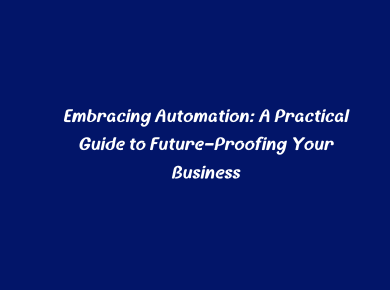In today’s competitive landscape, automation has become more than just a buzzword. It’s a strategic necessity for businesses looking to enhance efficiency, reduce costs, and remain relevant. However, diving into automation without proper planning can lead to wasted resources and missed opportunities. So, how do you ensure your business is ready for automation? Here’s a step-by-step guide to help you get started.
Understand the Potential of Automation
Before you implement automation, it’s essential to understand what it can and cannot do for your business. Automation isn’t a one-size-fits-all solution. While it can streamline repetitive tasks, improve accuracy, and free up your team for higher-value activities, it won’t replace the need for strategic human oversight.
Take time to research how automation is being used in your industry. Are competitors using robotic process automation (RPA), artificial intelligence (AI), or machine learning to optimize operations? Understanding these trends can provide valuable insights.
Assess Your Current Processes
Automation works best when applied to well-defined, repeatable processes. Start by mapping out your workflows to identify inefficiencies and bottlenecks. Look for tasks that:
- Are repetitive and time-consuming.
- Involve manual data entry.
- Require minimal decision-making.
For example, automating invoice processing or customer support inquiries can yield quick wins. Tools like process mapping software or business analysts can help you document and evaluate your workflows effectively.
Identify Goals and Key Metrics
Before you automate, define clear objectives. Are you looking to reduce operational costs, improve customer satisfaction, or speed up service delivery? Aligning automation initiatives with your business goals ensures a focused approach.
Next, establish key performance indicators (KPIs) to measure success. Metrics such as error rates, time savings, and customer response times can help track the impact of automation over time.
Choose the Right Tools and Partners
The market is flooded with automation tools, ranging from low-code platforms to advanced AI solutions. Selecting the right technology is crucial. Factors to consider include:
- Scalability: Can the solution grow with your business?
- Integration: Does it work seamlessly with your existing systems?
- Usability: Is the tool user-friendly for your team?
Additionally, consider partnering with experts or vendors who can guide you through the implementation process. They can help customize solutions to fit your unique needs.
Start Small and Scale Gradually
Automation doesn’t have to be an all-or-nothing endeavor. Begin with a pilot project targeting a single process or department. This allows you to:
- Test the technology in a controlled environment.
- Identify potential challenges and adjust accordingly.
- Build confidence among stakeholders.
Once the pilot is successful, gradually expand automation efforts to other areas of the business.
Invest in Training and Change Management
Introducing automation often requires a cultural shift within your organization. Employees may worry about job security or struggle to adapt to new workflows. Address these concerns by:
- Communicating the benefits of automation, such as reducing mundane tasks and enabling focus on strategic initiatives.
- Providing comprehensive training on new tools and processes.
- Involving employees in the automation journey to foster a sense of ownership.
Monitor, Optimize, and Innovate
Automation isn’t a set-it-and-forget-it solution. Regularly review the performance of automated systems to ensure they’re delivering the desired outcomes. Use analytics to identify areas for improvement and stay updated on emerging technologies to keep your business at the forefront of innovation.
Conclusion
Automation has the power to transform businesses, but its success hinges on thoughtful planning and execution. By understanding your processes, setting clear goals, and involving your team, you can unlock the full potential of automation. Start small, measure your results, and scale strategically to ensure long-term success. The future of business is automated—is your business ready to take the leap?




